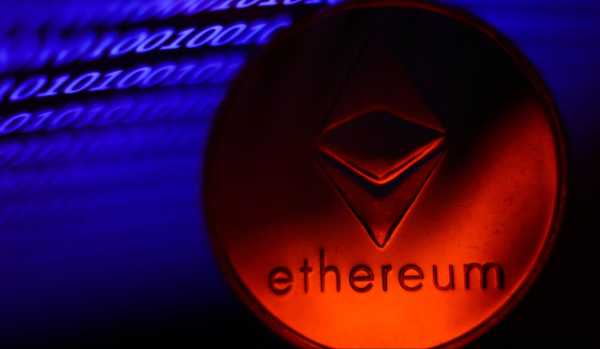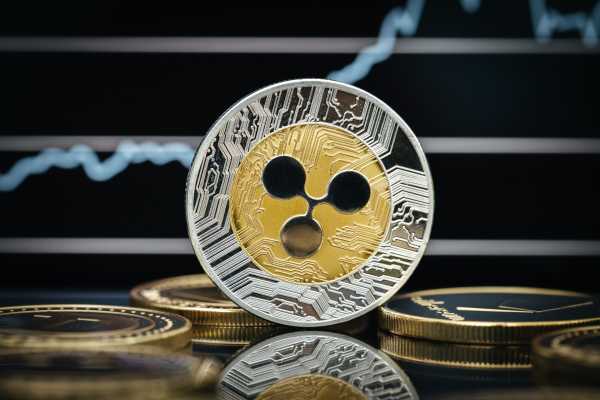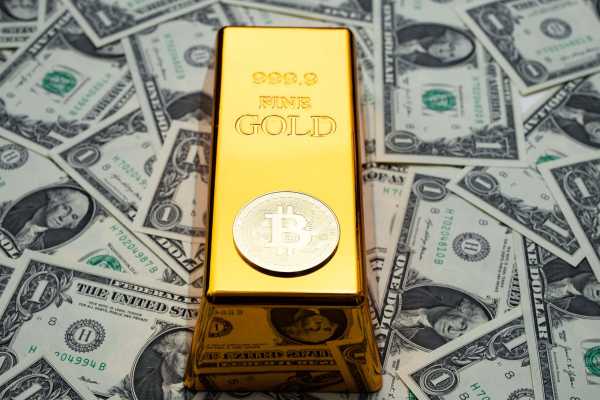What Is a Physical Bitcoin? How to Check if It Has Value
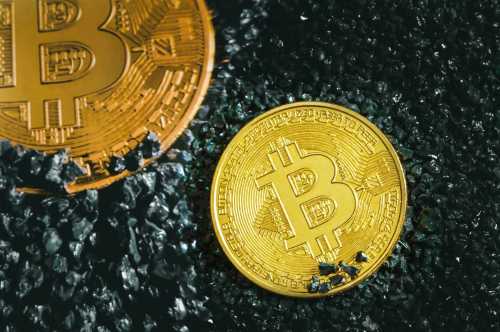
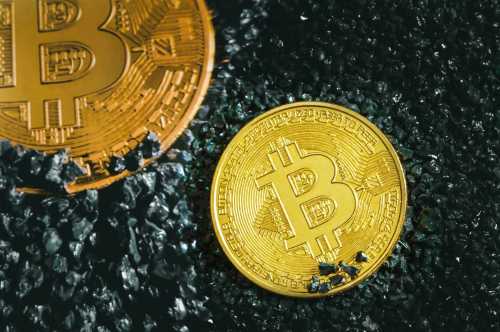
We’ve all seen stock images of a physical bitcoin, even though Bitcoin is a digital currency that exists in the zeros and ones of cyberspace. Although these images are often generated on a computer, physical Bitcoin is real, and you can still buy it today.
Many of the physical coins out in the wild are collectibles bearing the Bitcoin logo, but some hold the keys to actual Bitcoin. Let’s learn how to tell the difference and whether a Bitcoin physical coin has any value besides its collectibility.
What is Physical Bitcoin?
A Bitcoin physical coin is a metal or plastic coin bearing the Bitcoin logo. Some may be made of gold, silver, brass, or another metal, possibly adding to their value. Others may be made of plastic or used a metal plating over a less valuable material. In both cases, a physical bitcoin often looks and feels like a real coin.
Not all Bitcoin you can touch and hold is round, however. You will find that collectible Bitcoin exists in various forms, ranging from coins and cards to bills. Auction houses like Stack’s Bowers specialize in the rarest of cryptocurrency collectibles, typically resembling coins. During the 2021 crypto bull market, a collectible Bitcoin physical coin made by Casascius (no longer in production) fetched $1.69 million dollars. The coin itself, minted in 2011, held 25 bitcoins.

Physical coins can also hold the private keys for bitcoins on the blockchain that you can spend or send to another wallet. This usage is much less common, but companies like Ballet (founded by Bobby Lee, who also founded the BTCC crypto exchange) still sell collectible bitcoins that hold actual Bitcoin in various denominations.
How is Physical Bitcoin Made?
Manufacturing methods for physical bitcoins range from 3D printing to stamping. However, physical coins that hold actual BTC require some additional steps.
In addition to making the physical coin, the maker must also create a Bitcoin wallet and deposit Bitcoin in the coin’s wallet address. The process of creating a coin that holds actual Bitcoin requires using layered, tamper-resistant stickers that show the wallet address, private key, and passphrase. Many newer coins, like those made by Ballet, use QR codes and may even feature a mobile app to manage the coin’s BTC.
What is Physical Bitcoin Used For?
Most physical coins bearing the Bitcoin logo are collectibles or simply for amusement value. However, in rare cases, physical coins can hold the keys to real Bitcoin. Older examples that are both collectible and hold Bitcoin can sell for hundreds of thousands or even millions of dollars.
Collectible Items
Bitcoin collectible coins range from shiny trinkets available on Amazon and eBay to valuable coins that are in demand with collectors worldwide. In some cases, the collectible value of a coin that holds Bitcoin private keys can far exceed the value of the Bitcoin held in the coin’s wallet address.
The most valuable among these are the coins released by Casascius. The Cacasius coins can no longer be purchased directly but are popular at auctions, with “loaded” coins still holding Bitcoin. Lealana physical coins are also popular with collectors.
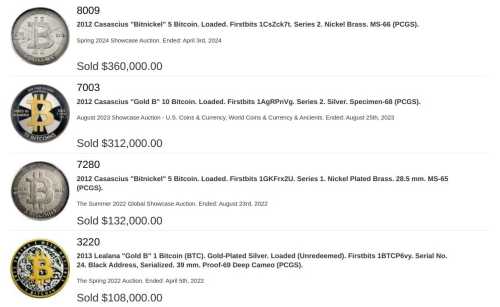
Stored Bitcoin Value (Rare)
The mass-produced novelty coins available on Amazon and eBay don’t hold any Bitcoin and aren’t sought after by collectors. However, coins that hold Bitcoin have value. These are much less common and typically circulate on auction sites like Stack’s Bowers and rare coin dealers.
Companies like Ballet still offer physical coins that hold a Bitcoin balance. Coins come loaded with a balance of 0.001 BTC or 0.25 mBTC.
Regulatory requirements for physical Bitcoin vary by jurisdiction, which limits the availability of coins in many regions. For example, in the US, dealers may need to register as a Money Services Business (MSB) and seek individual money transmitter licenses for each state in which they do business.
Physical Bitcoin Value: How Much is it Worth?
Most physical coins with the Bitcoin logo only hold entertainment value or serve as a way to show your support for Bitcoin as a cryptocurrency. However, collectible coins and those that hold real Bitcoin have real value.
Coins that hold Bitcoin show the value of the initial wallet on the coin itself. For example, in the image below, physical coins from Ballet show the value in Bitcoin. The coin pictured holds 0.001 bitcoins, or one milli bitcoin, which is about $58 based on the current BTC price.
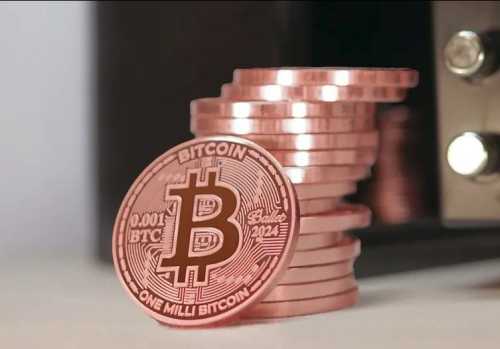
However, if the coin has been redeemed or tampered with, the face value may no longer be accurate. Each coin that holds BTC also comes with a private key to access the coin’s Bitcoin wallet. The wallet address may be visible, meaning it’s also possible to add to the value without accessing the wallet’s private key.
How to Check if a Physical Bitcoin is Real
The best way to avoid scams when buying physical Bitcoin is to purchase from a reputable source. For example, a Ballet coin purchased directly from Ballet is much safer than buying a Ballet from another source. For higher-value coins, such as Cacasius collectibles, an auction house like Stack’s Bowers provides a safer alternative.
A physical Bitcoin that holds BTC also displays a Bitcoin wallet address on the back of the coin.
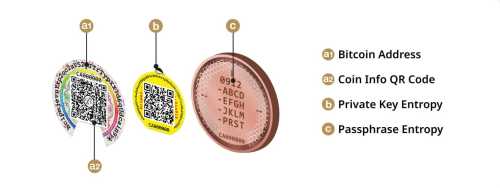
To verify the BTC balance of the coin, you can follow these steps.
1) Find the Wallet Address
Look on the back of the coin for a long string of letters and numbers starting with a 1, 3, or bc1. This is the wallet address. Some coins may also feature a QR code, which allows you to scan the coin with a mobile Bitcoin wallet like Electrum.
The address is a starting point. The balance may not match the face value, and it’s even possible that the Bitcoin address is not real.
2) Use a Blockchain Explorer to Verify the Balance
A blockchain explorer lets you see transactions and balances for any valid BTC address. Sites like Blockchain.com allow you to search by wallet address to see the balance for a specific address.

3) Verify the Tamper-Resistant Features
The wallet balance helps you verify the amount of Bitcoin stored in the coin’s wallet address. However, you’ll also want to verify that the wallet is secure. There should be a private key under the public wallet address. Verify that the public wallet address looks sound and is undamaged. If the public address sticker has been removed at any point, it’s possible that someone else has the private key as well and can access the wallet’s funds.
Is it Worth Buying Physical Bitcoin?
The origins of Bitcoin physical coins date back to 2011 when Mike Caldwell produced the first Casascius coins. At the time, the goal was to bridge Bitcoin as a digital asset with the real world of face-to-face transactions. The easy access to mobile Bitcoin wallets now, along with many merchants now accepting cryptocurrency payments, makes Bitcoin physical coins less needed.
However, physical coins that hold BTC still make thoughtful gifts, and the older collectibles are likely to increase in value. Novelty coins that don’t hold BTC aren’t likely to increase in value, though, making that type of purchase more of an indulgence than an investment.
Conclusion
BTC physical coins came about as a way to transact with bitcoins in the analog world. The earliest coins, including those from Casascius and Lealana, often fetch auction prices far exceeding their face value. Today, you can still buy physical Bitcoin, but most of the coins available through large platforms like eBay and Amazon are novelty coins with no real value. Auction houses like Stack’s Bowers and providers like Ballet still offer a way to buy physical coins loaded with BTC.
FAQs
Is there such a thing as physical Bitcoin?
Yes. Physical coins with the BTC logo range from novelty coins to coins with a Bitcoin wallet holding real BTC.
Can you get Bitcoin in physical form?
Yes. Auction house Stack’s Bowers offers collectible Bitcoin physical coins, with many of the coins holding real BTC. Ballet also offers coins that hold a Bitcoin balance.
Is physical Bitcoin a scam?
Some physical coins don’t hold any BTC. These may be novelty coins or they may be counterfeits of older coins, which can be very valuable if they are authentic.
What is the point in physical Bitcoin?
Physical Bitcoin was first introduced in 2011 as a way to transact with Bitcoin in everyday transactions. Today, mobile wallets replace the functionality of physical coins, but physical coins may still have collector value or make thoughtful gifts.
References
- Crypto Old-Head Otoh Talks Casascius Bitcoins, Tax Havens and Old Friends (finance.yahoo.com)
- Casascius physical bitcoins (bitcoin.it)
- Money Services Business (MSB) Registration (fincen.gov)
Source: cryptonews.com

